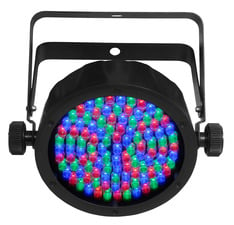Indoor LED Lighting
LED par cans are a very useful and versatile light fixture. They work great for:
- Uplighting
- Wall Washing
- Stage Lighting
- Dance Floor Lighting
You can set them up on the floor using the provided floor stands, or hang them from trussing or light stands. If you want to hang them, clamps are available to rent for an extra cost.
All lighting fixtures offer a built-in digital display for setting colors and basic patterns.
Which light is the brightest? Deciding between the Chauvet Slimpar 56 and the Hex 3?
Slim Par 56
The Slim Par 56 is our most popular option. They are RGB LED lights, and feature a built-in digital display to select a static color or pattern. Choose from 7 built-in colors.
![Slim Par 56 [white case]](https://www.prolightingrental.com/custom_assets/product/unit_photo/7/white_slimpar56.jpg)
Slim Par 56 [white case]
The Slim Par 56 is our most popular option, and this is the same light just the case is white instead of black. Choose from 7 built-in colors.

Slimpar 64 RGBA
Bigger and brighter! This is a nice upgrade that adds Amber, plus 13 color pre-sets.

Slimpar Hex 3 IRC
Get lots more color options with these RGBAW+UV lights. 63 colors to choose from + black light!

Wireless EZPar 56
Wireless Uplighting! Built-in battery that will keep the lights powered on for up to around 12 hours. 7 color pre-sets.

Wireless Par 64 RGBA
Battery powered lights with 15 color presets. Very bright in size Par 64. Includes an Amber bulb for warm color options
